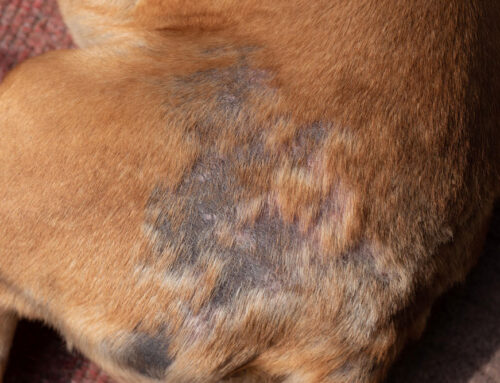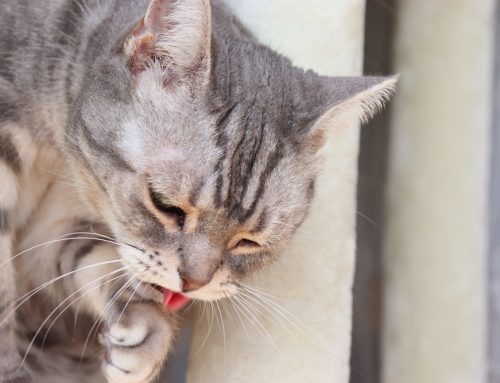Heading to a cool body of water sounds like the perfect way for you and your furry pal to beat the summertime heat, but that refreshing dip could be dangerous for your pet. Before hitting the beach for a fun-filled day in the water, Tidmore Veterinary Hospital wants you to learn about potential water hazards that can harm your pet.
#1: Blue-green algae toxicity in pets
Cyanobacteria, also known as blue-green algae, are microscopic bacteria found in freshwater lakes, streams, ponds, and brackish water ecosystems. They can produce toxins that affect people, livestock, and pets that swim in and drink from the algae-contaminated water, and only a few mouthfuls can be fatal.
Blue-green algae grow to form “blooms” that give the water a blue-green appearance, or make the water look like the surface is coated with blue or green paint. Because the algae float, the wind can blow them into thick mats near the shore, making them easily accessible—and especially hazardous—to pets and people. This algae is most abundant during the hot weather in the mid- to late-summer months, and, while most blue-green algae blooms do not produce toxins, their presence cannot be determined without testing. Treat any blue-green algae bloom that you spot as toxic, and stay far away.
The algae’s musty or foul smell can be especially attractive to dogs, and your pooch may dive right in if left unattended. However, drinking contaminated water can be fatal. Blue-green algae toxicity signs in pets include:
- Vomiting
- Diarrhea
- Blood in the stool
- Black, tarry stool
- Weakness
- Pale mucous membranes
- Jaundice
- Seizures
- Disorientation
- Coma
- Shock
- Excessive drooling
- Muscle tremors or rigidity
- Paralysis
- Blue discoloration of the skin and mucous membranes
- Difficulty breathing
Signs differ based on the toxin type your pet was exposed to, but the toxins are quick-acting and potentially fatal without aggressive, immediate treatment.
#2: Red tide and pets
Like blue-green algae blooms, a red tide is a type of harmful algal bloom. Red tides are typically found in salty coastal waters in bays and estuaries, and do not form in freshwater systems.
Red tide toxins can cause neurologic and respiratory issues. If your pet chews on a seashell, ingests water, or eats a fish that died from red tide toxins, they also can suffer from toxicity, as shown by:
- Tremors
- Seizures
- Paralysis
- Difficulty breathing
Help prevent toxicity in your pet by not allowing them to play in the foam that can accumulate on the beach during or after a red tide, since the foam is 10 times more toxic than the water.
#3: Saltwater toxicity in pets
If too much is ingested, saltwater is toxic to pets, so the next beach day you share with your pup, monitor them closely to prevent saltwater toxicity. Ocean-soaked tennis balls and other absorbent fetch toys can contain enough salt to cause issues.
A small amount of saltwater can cause diarrhea in your pet, as the excess salt in their system will draw water from the blood into the intestines. The diarrhea can contain blood and mucus. If your dog drinks a large amount of saltwater, toxicity can cause vomiting, dehydration, incoordination, and seizures.
Avoid saltwater toxicity by taking a break every 15 minutes and offering your dog fresh water. Once you’re done playing on the beach, rinse your pet’s fur thoroughly to remove every trace of salt, and also scrub their collar and leash.
#4: Your pool can be a swimming hazard for pets

While swimming in natural bodies of water can expose your pet to a whole host of pathogens and toxins, swimming in your own pool can also be hazardous. Keep in mind that not all pets instinctively know how to swim, so watch your pet closely the first time they venture into deep water. If you want your pet to enjoy your swimming pool with you, but they are not a graceful swimmer, outfit them in a properly fitted life vest.
When you’re not able to watch your four-legged pal around your pool, ensure you block any access. Shut the gate to your pool, and don’t assume a pool cover will prevent your pet from jumping or falling in. And, because of added chemicals, do not let your pet drink from your pool. Provide plenty of fresh water so your furry friend doesn’t turn to the chlorinated water when they need a drink.
If your pet does swim in contaminated water, wash them immediately to remove the toxin. Pets often lick their fur to help them dry off after swimming, and can easily ingest the toxin at that point. Monitor the presence of algae blooms in your swimming areas, and avoid these regions to keep your furry pal safe. But, if your four-legged friend runs afoul of a water hazard, contact our Tidmore Veterinary Hospital team for help.








Leave A Comment